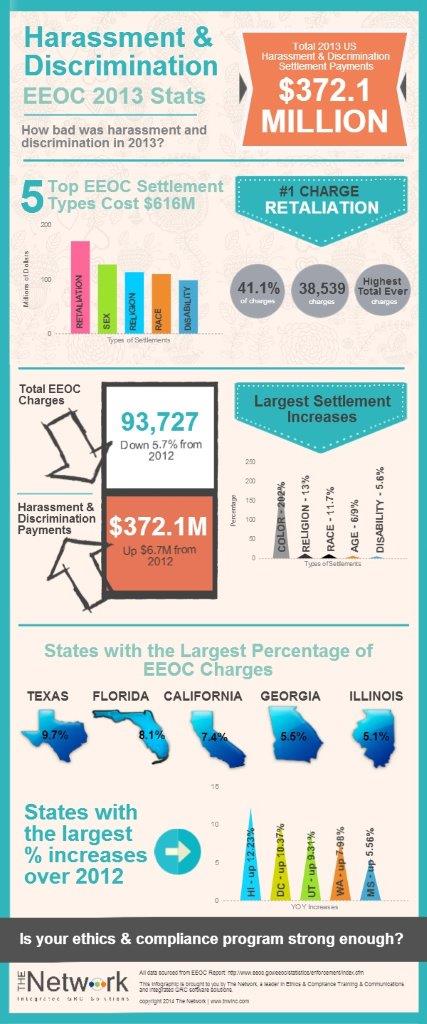
Today we have an interesting look at EEOC claims in the past year. Jimmy Lin — Vice President of Product Management and Corporate Development at The Network, a leader in providing integrated governance, risk and compliance solutions — dives into the subject, offering a peek into the trends, the biggest offenders and what organizations can do to protect themselves. –Maurice Gilbert
Harassment and discrimination issues can lead to millions of dollars in losses for an organization. In fact, the Equal Employment Opportunity Commissions (EEOC) obtained the highest amount of monetary recoveries in agency history in 2013, despite the overall number of harassment and discrimination charges decreasing from 2012. This increase in settlements shows that while fewer cases are being filed, fines are getting larger and regulations are getting stricter.
Most companies spend the majority of their time worrying about the financial burden of harassment and discrimination charges, and rightfully so; however, losses can come in many other forms. One case has the potential to damage an organization’s reputation, reduce employee morale and employee retention rates and lose the company’s support within the entire industry or even lead to the point of failure. To eliminate such claims from the workplace, organizations must work diligently to raise the bar when it comes to ethical behavior.
There are several ways organizations can protect themselves from the fallout of harassment and discrimination. To get employees engaged with the company’s standards of behavior, ensure that your code of conduct clearly outlines the company’s expectations for how employees are to act and treat each other in the workplace. Further, organizations should have a clearly written and easily understandable policy on harassment and discrimination that not only defines what that type of behavior is, but also establishes what the consequences are for engaging in it and provides step-by-step instructions on what to do if an employee learns of a violation to that policy.
Finally, organizations must provide training to employees on the harassment and discrimination policy. Training can come in many forms: classroom, online, video or interactive, but either way, it should be engaging to the employees so that they remember the material and apply its principles each day. Simply handing out an updated policy manual to employees and showing a video is not enough. These efforts must start with a comprehensive workplace training program that includes education on the updated policy, follow-up awareness training and ongoing awareness communication. Harassment and discrimination training can’t be viewed as a one-time exercise. If organizations promote a more positive work environment on a regular basis, employees will follow suit. The company culture will benefit and the reputation of the company will remain intact.
 Jimmy Lin leads corporate and product strategies for The Network’s Integrated GRC Solutions. He has over 15 years experience in and around software and technology, from implementing software to analyzing new markets and leading product strategies for organizations like Oversight Systems, Manhattan Associates, UPS Supply Chain Solutions and IP2Biz. Jimmy is a Certified GRC Professional (GRCP).
Jimmy Lin leads corporate and product strategies for The Network’s Integrated GRC Solutions. He has over 15 years experience in and around software and technology, from implementing software to analyzing new markets and leading product strategies for organizations like Oversight Systems, Manhattan Associates, UPS Supply Chain Solutions and IP2Biz. Jimmy is a Certified GRC Professional (GRCP).



